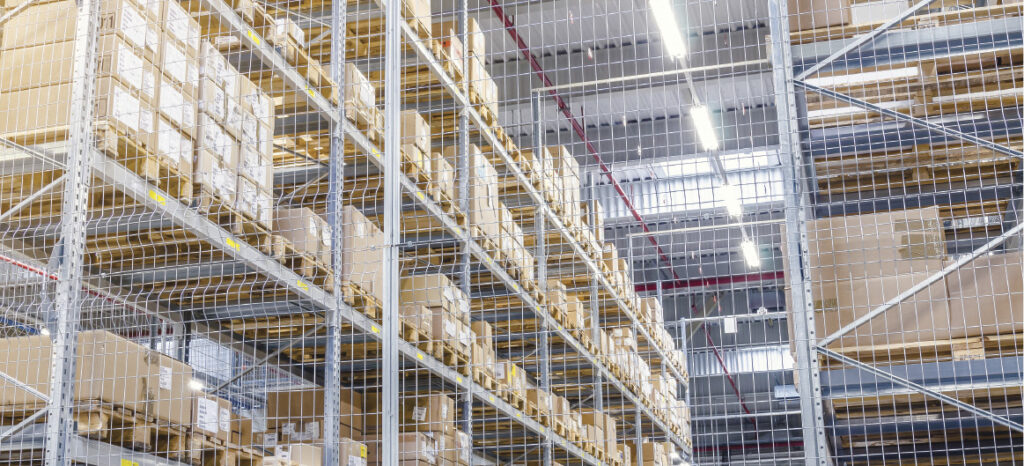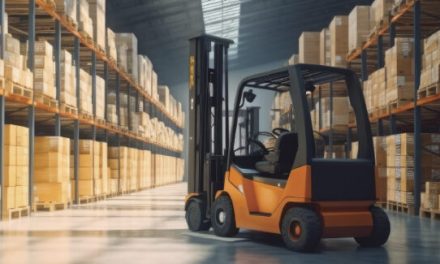© romankrykh – stock.adobe.com
Solutions are available to keep workers safe and make products more accessible.
By: Maureen Paraventi
Industrial netting can be a reliable, cost effective way to keep people safe and inventory undamaged. It is a fixture in many warehouses, distribution centers and other facility types. Although netting seems relatively simple – especially in a landscape that may include automation, robotics, conveyors and other complex equipment – there are some important things to keep in mind when choosing and using it:
- Netting is not a one-size-fits-all solution. It must fit and be designed for specific structures, like racks, conveyors, ledges, mezzanines, door openings, loading docks and hatches.
- Netting runs hot and cold. For hazardous environments or refrigeration applications, choose netting that is flame retardant or designed to maintain its integrity in frosty conditions. Also available: netting that is chemical resistant.
- Some netting has zippers. Where and why would this type of netting be useful? Retrieving products that fall from conveyors into netting sometimes involves cutting the netting. Although parts can be rejoined using fasteners, the integrity of the netting is compromised – especially after repeating cuttings and rejoinings. Using netting with zippers with conveyors gives workers easy access to fallen products.
- May the netting force be with you. (I couldn’t resist.) When selecting netting for a specific application, it is necessary to determine how much force and weight it will have to handle. Will the netting you install have to catch lightweight objects? Heavy palletized goods, falling from height? Will it have to stop a runaway forklift? Among other factors, netting products are rated by force limits. A thorough assessment of falling object hazards in your workspace, coupled with a consultation with your netting supplier, will ensure that the netting you use will be sufficient. In areas where extreme force is a possibility, an alternative to netting may be necessary.
- You can have protection and access with netting. Reluctant to install netting with some racks because workers need to be able to get to inventory? Rollup netting that rolls up and down can keep workers safe and products accessible.
- Netting materials vary. Many industrial netting products are made of polypropylene (PP), a strong and durable thermoplastic polymer. PP is available in strengths from light duty to heavy duty and is resistant to heat and a range of chemicals. Metal netting is strong and long-lasting. In cable form, metal cable is ideal for heavy loads. Metal chain netting can absorb heavy loads and withstand extreme conditions without experiencing much wear and tear. PP netting is less costly than metal although metal is a better choice when objects have sharp corners or edges that might cut PP netting.
- Opening size should relate to load weight. Netting that is rated for a 2,500-pound pallet typically has openings that are 2” x 2”. However, a 1” x 1” mesh is more effective for heavier loads that exceed 3,000 pounds.1 Your netting supplier will be able to provide you with capacity specifics for the products you order.
- Building codes may call for netting. Local building and fire codes should be a consideration when deciding on netting for your facility. In earthquake-prone areas, there is a greater risk of objects falling from racks. Netting can address that, as well as fire code requirements in some localities for open flue spaces around rack-stored pallet racks, so that overhead sprinkler systems can operate effectively in case of fire.2 WMHS
- 1
- 2
OSHA’S Netting Requirements
OSHA’s 1926.105 standard1, Safety Nets, mandates safety nets when workplaces are more than 25 feet above the ground or water, or other surfaces where the use of ladders, scaffolds, catch platforms, temporary floors, safety lines, or safety belts is impractical. Operations cannot happen until the net has been installed and tested. This should include impact load testing for clearances.
Nets must extend 8 feet beyond the edge of the work surface where employees are exposed to falls. They must be as close under the work surface as practical, but no more than 25 feet below the work surface.
Nets shall be hung with sufficient clearance to prevent user’s contact with the surfaces or structures below.
The mesh size of nets shall not exceed 6 inches by 6 inches. All new nets shall meet accepted performance standards of 17,500 foot-pounds minimum impact resistance as determined and certified by the manufacturers, and shall bear a label of proof test. Edge ropes shall provide a minimum breaking strength of 5,000 pounds.
Forged steel safety hooks or shackles shall be used to fasten the net to its supports.
Connections between net panels shall develop the full strength of the net.
1
The post Eight Things to Know About Netting appeared first on Workplace Material Handling & Safety.





